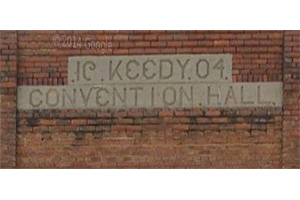
 |
 |
|||||||||||||||||||||||||||||||||||||||||||
Behold, the generic design going up in every city across the land. And that’s not necessarily a bad thing.
Plays nicely with its neighbors, and some day it will lose the ridiculous awnings - they look cool, but serve no purpose. That’s usually a sign a street is on the way up. Let’s go up and down the block and see what’s left.
Revived, restored, repainted: good.
And that's a good sign.
Speaking of generic: it’s every small bank in America - except here it’s a branch of LIBERTY, which is still around.
A bit sad and forlorn, like money isn’t something people use anymore.
Uh oh. This needs some love. It looks like a Jenga tower, in a way:
And then this. Explain the sequence of events that led to that back end.
Go on, try. Make it something plausible. I can’t. Perhaps the windows and door faced an alley that no longer exists - but it’s obvious something else was built and then destroyed. Fire? Gravity?
A story-book roofline above; blind-pig window / door combo below.
The greatest stock of early 20th century commercial architecture can be found in "challenged" neighborhoods - but there are some who think that the worst thing that could happen to those storefronts would be Starbucks and Pret a Manger.
Oh dear.
That’s some first-class Earnest Rehabbing there, but it never works if you leave the second-story bay windows hanging out like butt cheeks.
Care and consideration went into this one, but it’s like doing a meticulous make-up job on a corpse.
It would be amusing if the door was just painted, an optical illusion intended to trick Road Runners.
Empty, but obviously rehabbed. It’s a W. T. Grant store, right? Unless someone else said “that’s my name too, so screw you big chain store.” I didn’t know they made Moderne stores like this; must have had Kress envy.
Dorsen:
A four-story structure built in 1923. Classic commercial structure of the era; white terra-cotta applied liberally. The sign of prosperous confidence. If it had been 1929 they would have made it four times bigger - because things would always be rolling right along.
Hairy dude and his weird, uptight old aunt:
I wonder what flags hung on those poles - unless they're antennae for communicating with the mothership.
Another good sign:
Old warehouse / factory buildings make for great modern office spaces - big open floors, so the millennials can play bowling or zip around in electric cars before flopping down in a ball pit for a meeting about the new app.
Feinally:
Beautiful structure, with that California-theatrical addition of the pointless vases. no, it wasn't a mobie theater: it's been the Fein Bros restaurant supply company forever. |
||||||||||||||||||||||||||||||||||||||||||||
 |
 I was looking for a factory on an old matchbook, and came across a neighborhood in Milwaukeee - the street now named MLK. Previously 3rd street, mostly German in the early years - which may explain some of the architecture.
I was looking for a factory on an old matchbook, and came across a neighborhood in Milwaukeee - the street now named MLK. Previously 3rd street, mostly German in the early years - which may explain some of the architecture. 






























